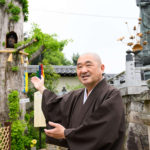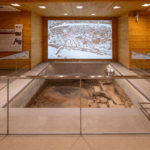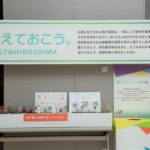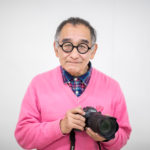2 “After That”
Atomic bombs are definitely different from other weapons. One of the significant reasons for that is the delayed effects of radiation damage that develop later on, the so-called after-effects of the atomic bombing. Delayed effect radiation damage is the development of syndromes after an incubation period of several years to decades after recovering from acute damage. Also, after receiving low doses of radiation at the level which does not cause damage for years, or repeated low doses of radiation, effects may appear after a certain period of time. Common diseases which increase incidence rates after atomic radiation exposure are leukemia, thyroid cancer, breast cancer, lung cancer, stomach cancer, colon cancer, multiple myeloma, cataracts, somatic mutation, and intellectual disorders of children exposed in utero (a-bomb microcephaly) 14). At the same time, many years of epidemiological studies have revealed developmental risks. For example, when receiving a dose of 1 Gray of atomic bomb radiation (exposure to radiation approximately 1.3 km from the hypocenter in Hiroshima), the relative risk of death by leukemia is 4.92, which is nearly five times higher than people who are not exposed to atomic bomb radiation. Regarding other solid cancers, risks are also one to two times higher. 15) In recent years, myelodysplastic syndromes, known as preleukemia, has drawn attention as a disorder which increasing numbers of a-bomb survivors develop, and its molecular mechanism of development has been under investigation. 16) The most characteristic feature of atomic bomb damage is this delayed-effect radiation damage. In addition, a-bomb survivors have to live with anxiety about the delayed effects of radiation damage that they may develop at any time.
This health concern should be noted as continuing atomic bomb damage and also is considered a notable feature of “after that” damage. The seriousness of the atomic bomb damage is indicated here. According to a survey by the Japan Confederation of A-and H-Bomb Sufferers Organization in 1985, 71% of respondents expressed concerns on health, life and their offspring (Ito, 1998:61-62). In a survey by the Asahi Shimbun in 2005, 48% (4,856 respondents) answered “always concerned,” 46% (4,638) answered “occasionally concerned,” revealing that over 90% of all respondents feel health uneasiness (Kawano 2010a: 26). Of course, many elderly people who were not exposed to atomic bomb radiation suffer from health concerns. However, at least, there is no concern that they may develop diseases caused by radiation exposure. In fact, in a 2015 survey by the Asashi Shimbun, 55% (3,193 respondents) answered “When my health condition gets worse, I worry that it is caused by radiation effects.” In addition to their health concerns, many a-bomb survivors are worried about the health of their children and grandchildren. The survey by the Asahi Shimbun in 2015 asked, “Do you have concerns about birth or anxiety about your children or grandchildren’s health?” and 58% of respondents said they have felt uneasy. In a recent survey by the Asahi Shimbun in 2015, 47% responded “Yes” to the question “Do you have concerns about your children or grandchildren’s health due to the influence of your exposure to atomic bomb radiation?” In a survey by the Yomiuri Shimbun in 2015, nearly 56% said “Yes” to the question “Regarding the health of your children and your grandchildren, are you concerned about the effects of your a-bomb radiation exposure?” Thus, a-bomb survivors feel uneasy about the health of their children and grandchildren in addition to their own health concerns. It is necessary to understand that the psychological effects resulting from the atomic bomb experience is one of the characteristics of “After that” damage.
There are other cases showing the psychological damage or stress caused by the atomic bombings or doses of atomic bomb radiation. A-bomb survivors dream about their a-bomb experience and recall it in daily life. In a survey by the Asahi Shimbun in 2005, there was a question “Do you dream about your a-bomb experience?” 9.5% answered “frequently,” and 45% said “occasionally,” revealing that 55% dream about their a-bomb experience. In addition, to the question “Do you recall your a-bomb experience in your daily life?” in the same survey, 76% answered “often” or “sometimes.” A survey conducted by the Yomiuri Shimbun in 2015 asked the same question and 74% responded “frequently” or “sometimes.” Incidentally, in the 2005 survey by the Asahi Shimbun, respondents mentioned, as things that evoke the atomic bomb experience, that flashes (the flash of the atomic bomb), crowds at a festival (a-bomb survivors walking along a railway when they escaped to the suburbs), traces of the 2004 Indian Ocean earthquake and tsunami (remembering looking for a mother for days in the debris), cucumber slices (burned people put them on their burn injuries), grilled dried squid (the smell of burning bodies). The 2015 survey by the Yomiuri Shimbun asked when a-bomb survivors remember the a-bomb experience. 62% answered “When I watch news about overseas conflicts and nuclear weapons”, 22% said “When I see intense lights, flame, etc.” and 16% said “When I dream about it”.
The “after” atomic bomb damage includes not only such psychological effects but also social damage. Prejudice and discrimination against a-bomb survivors are examples. The 2005 survey by the Asahi Shimbun asked about prejudice and discrimination. 2,674 respondents, which is approximately 20%, answered that they had been subjected to discrimination or prejudice due to the fact that they were a-bomb survivors. Among them, 1,996 respondents (74%) referred to discrimination and prejudice at the time of marriage. Also, in the survey by the Yomiuri Shimbun in 2015, they asked the same question. Nearly 28% answered that they had experienced discrimination “in the past,” and 4.5% said prejudice and discrimination “still exist.” Thus, “after” a-bomb damage involves not only the after-damage of the atomic bombings, but also the psychological effects such as health concerns and social damage caused by being an a-bomb survivor.
14) Peak onset time after bomb exposure varies for different illnesses—6-7 years later for leukemia; ten years later for thyroid cancer; 20 years later for breast and lung cancer; 30 years later for stomach, colon, and bone cancer—and thereafter slowly declines. For details, consult the digest of the Hiroshima International Council for the Healthcare of the Radiation Exposed, etc.
15) Digest of the Hiroshima International Council for the Healthcare of the Radiation Exposed, pp.24-34.
16) A representative research team is the group headed by Professor Harada Hironori at Tokyo University of Pharmacy and Life Sciences Laboratory of Oncology. For the previous findings of Hironori and his colleagues’ work, as well as work on the molecular mechanisms of the onset of MDS, see Hironori Harada and Yuka Harada (2015).







